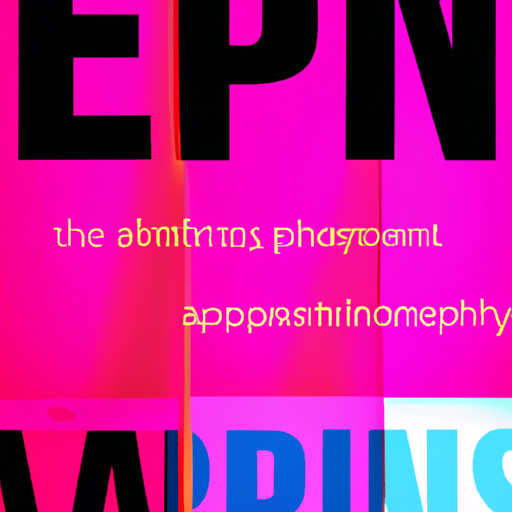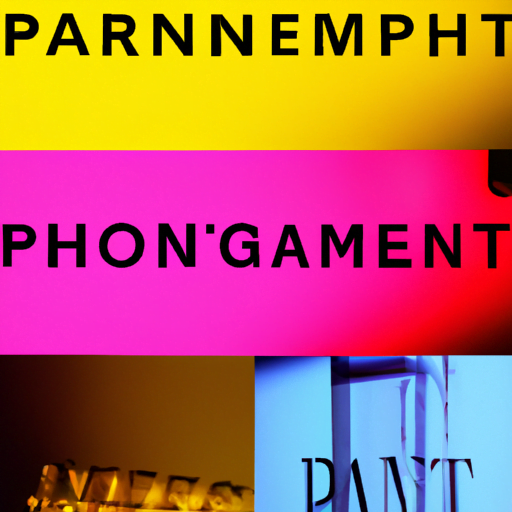
-
Table of Contents
- Experimental Typography: Pushing the Boundaries
- The Evolution of Typography
- The Impact of Experimental Typography
- Examples of Experimental Typography
- 1. “The Crystal Goblet” by Beatrice Warde
- 2. “The Beauty of Letterpress” by Neenah Paper
- 3. “Typography in Motion” by AIGA
- The Future of Experimental Typography
- Key Takeaways
- Conclusion
Experimental Typography: Pushing the Boundaries

Typography is an essential element of design that has the power to convey meaning, evoke emotions, and enhance the overall visual experience. While traditional typography has its place, experimental typography pushes the boundaries of what is possible, challenging conventions and creating unique and captivating designs. In this article, we will explore the world of experimental typography, its impact on design, and the exciting possibilities it offers.
The Evolution of Typography
Typography has come a long way since the invention of the printing press in the 15th century. Initially, typography was limited to the use of traditional typefaces and layouts. However, with the advent of digital technology, designers gained the freedom to experiment with typography in ways never before possible.
Experimental typography emerged as a response to the desire for more creative and expressive designs. It breaks away from the constraints of traditional typography and explores new techniques, materials, and forms. By pushing the boundaries of what is considered “typical,” experimental typography opens up a world of possibilities for designers.
The Impact of Experimental Typography
Experimental typography has had a profound impact on the design industry. It has revolutionized the way we think about and use typography, pushing the boundaries of what is considered “normal” or “acceptable.” By challenging conventions, experimental typography has sparked creativity and innovation in design.
One of the key impacts of experimental typography is its ability to create unique and memorable designs. By breaking away from traditional typefaces and layouts, designers can create visually striking compositions that capture the attention of the viewer. This can be particularly effective in advertising and branding, where standing out from the competition is crucial.
Experimental typography also allows designers to convey meaning and evoke emotions in new and exciting ways. By manipulating the form, size, and arrangement of type, designers can enhance the message they are trying to communicate. For example, a designer may use distorted and fragmented typography to convey a sense of chaos or confusion, or they may use oversized and bold typography to convey a sense of strength and power.
Examples of Experimental Typography
There are countless examples of experimental typography that showcase the creative possibilities it offers. Let’s explore a few notable examples:
1. “The Crystal Goblet” by Beatrice Warde
In her famous essay “The Crystal Goblet,” Beatrice Warde challenges the notion that typography should be invisible and transparent. She argues that typography should be seen as a form of art and expression, rather than a mere vessel for content. This essay is a prime example of how experimental typography can challenge conventions and provoke thought.
2. “The Beauty of Letterpress” by Neenah Paper
Neenah Paper’s “The Beauty of Letterpress” project showcases the beauty and versatility of letterpress printing. The project features a collection of stunning letterpress prints created by various designers, each pushing the boundaries of what is possible with this traditional printing technique. The result is a series of visually captivating and tactile designs that celebrate the art of typography.
3. “Typography in Motion” by AIGA
AIGA’s “Typography in Motion” project explores the intersection of typography and motion design. The project features a collection of animated typographic compositions created by designers from around the world. These animations push the boundaries of traditional typography by adding movement and interactivity, resulting in dynamic and engaging designs.
The Future of Experimental Typography
As technology continues to advance, the possibilities for experimental typography are only expanding. With the rise of virtual reality, augmented reality, and interactive design, typography can now exist in three-dimensional space and interact with the viewer in new and exciting ways.
Additionally, advancements in digital tools and software are making it easier than ever for designers to experiment with typography. Designers can now manipulate type with precision, create custom typefaces, and explore new techniques and effects. This accessibility is fueling a wave of experimentation and innovation in the field of typography.
Key Takeaways
- Experimental typography pushes the boundaries of traditional typography, allowing designers to create unique and captivating designs.
- Experimental typography has had a profound impact on the design industry, sparking creativity and innovation.
- Experimental typography can create visually striking compositions and evoke emotions in new and exciting ways.
- Notable examples of experimental typography include Beatrice Warde’s essay “The Crystal Goblet,” Neenah Paper’s “The Beauty of Letterpress” project, and AIGA’s “Typography in Motion” project.
- The future of experimental typography looks promising, with advancements in technology and digital tools opening up new possibilities.
Conclusion
Experimental typography is a powerful tool that allows designers to push the boundaries of what is possible. By challenging conventions and exploring new techniques, materials, and forms, designers can create unique and captivating designs that leave a lasting impression. As technology continues to advance, the future of experimental typography looks promising, offering even more exciting possibilities for designers to explore. So, embrace the experimental, and let typography take you on a journey of creativity and innovation.
